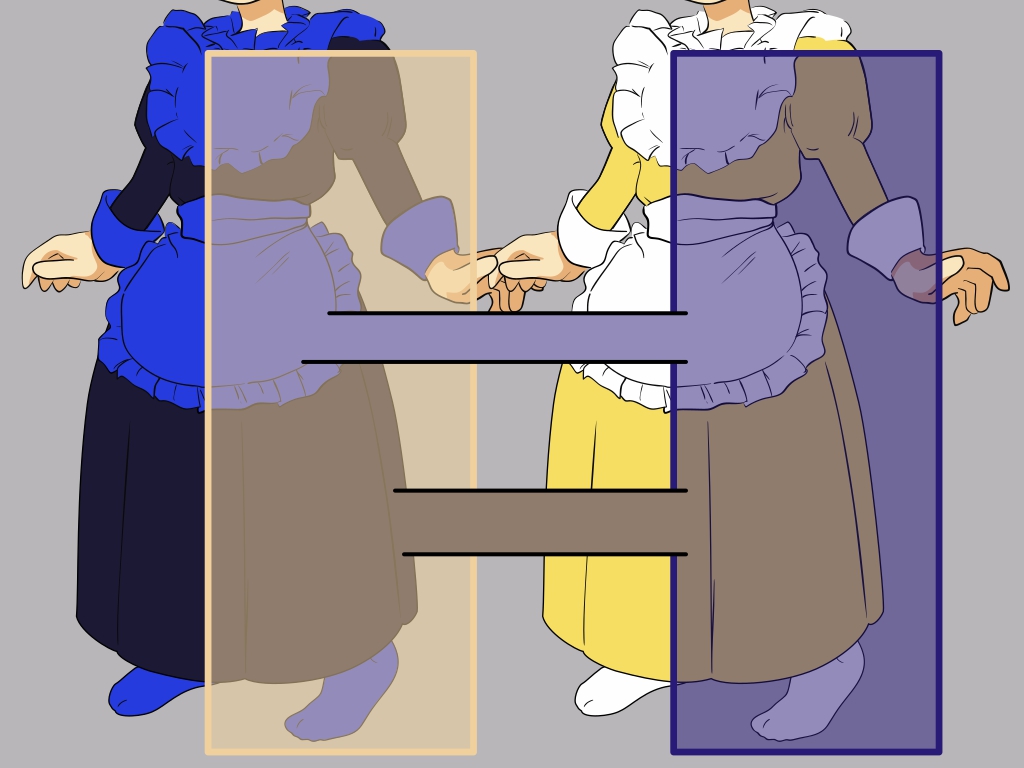

If a mirror is treated as an ordinary object, an interesting question arises: what color is the mirror?
Some people may think that a mirror has no color. It is whatever color it reflects. Others think, isn't a mirror just silver? In everyday life one could say this, but to be serious, neither of these answers is entirely correct. In order to find out "what color is a mirror", we must first understand what color is and where it comes from.
Light vs Color
We see things because the light they emit enters our eyes and is refracted and projected on the retina through the eyeball structure. The light signals are converted into electrical signals by the photoreceptor cells, then transmitted to the brain through the nerve, and finally processed and imaged by the visual center of the brain. The different colors we see actually correspond to different combinations of visible light of various wavelengths.
It is the cone cells in the retina that are responsible for identifying different wavelengths of light. Most people have three different types of cone cells, which are sensitive to blue light (shorter wavelength), green light (medium wavelength) and red light (longer wavelength). The combination of different intensities of the three signals is processed by the brain to create a wealth of colors.
However, the above is the way people "see" color, not the way they "understand" color. When you see beautiful mountains and rivers, you do not need to think about "how much blue light, how much green light, and how much red light there", but will say "the distant mountains are gray blue, and the river is dark green".
This expression reflects our understanding of the three dimensions of color: hue, saturation, and value. The difference in hue, such as blue and green, corresponds to the wavelength of the main light; The difference in saturation, such as blue and gray blue, corresponds to the complexity of light; The difference in lightness, such as light green and dark green, corresponds to the amplitude of light waves.

(Image source: Sharkd / Wikimedia Commons)
You may find that there is no white light in the visible spectrum. White is not a hue, but white can be a color. After a variety of colors with sufficient intensity are mixed, a color with no prominent hue, low saturation and high lightness is formed. In our brain, it is white. Sunlight is a kind of white light, which contains all wavelengths of light in the visible spectrum.
When an object is irradiated with white light, it will absorb some wavelengths of light and reflect some wavelengths of light. The color of these reflected light is what we usually call the color of the object. Why should we emphasize "in white light"?
Imagine an extreme scenario: there is a blue car that can absorb all wavelengths of light except blue. It is parked under the only street lamp that emits red light. The light from the street lamp will be completely absorbed by the car body, so that the car looks black. Thus, color is not an inherent property of an object. But we still say "there is a blue car parked there", because what we usually say about the color of the object is for white light.

It is unrealistic to talk about the color of an object in isolation from the light conditions. When people ask about the "original color" of a dress, they are asking what color the dress would be in white light. (Image source: Wikipedia)
Back to the question of "what color is the mirror". The common aluminium or silver plated glass mirrors reflect almost all light. When white light shines on a mirror, the reflected light is naturally white. Therefore, we can say that mirrors are white. The reason why "a mirror is whatever color it reflects" is not a good answer is that it ignores the fact that we usually discuss the color of objects in the context of white light.
However, the answer of "white" is not perfect. The reflected light of the metal aluminum or silver used for making the mirror has no particular color deviation. But don't forget that this layer of metal is preceded by a layer of glass, and the commonly used silicon glass has the weakest ability to absorb green light. A physical study in 2004 found that the maximum reflection spectrum of the mirror is between 495 and 570 nm, which is equivalent to green. In other words, the mirror is white with a little green.
Usually, this green tone is difficult to detect, but when we place the two mirrors opposite each other and let the light reflect between them, this green tone will become obvious. This device is called "mirror tunnel" or "infinite mirror". At the deeper position of the mirror tunnel, it can be clearly seen that the color is darker and greener.
Color of Metal
I'm sure there are people who can't accept the answer "mirrors are white (with a greenish tint)". (Actually, I can't really accept it either.) You may be thinking: a mirror looks completely different from a white wall or a white piece of paper. Aren't mirrors silver?
Let's look at what "silver" is. The name "silver" is found in some standard color charts, such as #c0c0c0 in the Web color chart.

Is it not quite the silver color you thought it would be? Does it feel like just plain grey? What about this:

It has a bit of a silvery look to it now. But I didn't change the color value, I just added a gradient effect. As you can see, what we call "silver" in life is not a real "color", but a greyish-white state with a shiny finish. The same is true of metallic colors such as gold.
The difference in visual effect between a "white" mirror and a white paper or wall is simply due to the different patterns of reflection. The 'silver' color of the mirror is not a special 'color' as opposed to white, but rather refers to the metallic shine of the mirror reflection.
Visible light, as an electromagnetic wave, causes a plasma near the surface of a metal to oscillate when it hits it. The plasma will thus produce another electromagnetic wave that is the opposite of the incident one, the reflected light. There is little energy loss in this process and the reflected light from the metal can therefore be very bright.
If the frequency of the incident light is relatively low, such as visible and infrared light, the electrons can move at a speed that matches it and the incident light can be reflected by the metal; but if the frequency of the incident light is too high (such as ultraviolet light), the electrons cannot match its speed and the metal will be penetrated by the light. Different types of metal have different abilities to reflect light. Silver, for example, is transparent to ultraviolet light at wavelengths of less than 140 nm, but has good reflectivity in the visible band and is therefore suitable for use as a mirror.
Color vs Gloss
At this point, there is no dispute that mirrors are basically white, but there is another "outrageous theory" worth mentioning: the perfect mirror is black. Why does this claim arise?
You can look up and observe objects around you that have a glossy finish, such as ceramic mugs, plastic bags, or even some fruits with a glossy surface. In the example of the apple in the picture below, it is clear that the white spot is the effect of a specular reflection of the light source on the surface of the apple, while the red part is a diffuse reflection. As previously defined, the reflected light when an object is illuminated by white light is the colour of the object, so if you were asked to describe the colour of the apple, would you say white for specular reflection, or red for diffuse reflection?

Waxed apples, where a distinct mirror reflection can be observed (Picture source: Pixabay)
I believe that the vast majority of people do not think that an apple is white just because it reflects light. In other words, the "color" and the "gloss" of an object need to be discussed separately, with the diffuse reflections being classified as "color" and the specular reflections as "gloss". The specular reflections are classified as "gloss". Although the two are often confused in life, in areas such as the paint industry, where more visual impact is required, color and gloss often need to be described separately.
Gloss affects color, which is well understood. When the amount of incident light is a certain amount, more is used for specular reflection and less for diffuse reflection. This is why, for the same material, a smooth surface usually looks darker than a matt surface.
So what color are mirrors? The conventional answer is "white (greenish)", the answer that distinguishes between color and shine is "dark grey (greenish)", and, in life, without being too literal, "silver", which combines color and shine, is also a good answer.
The color of a mirror depends on your definition of what the color of an object is, and there is no need to seek a single answer. It is probably more important to gain a better understanding of how humans observe color, recognize it and describe it by discussing the somewhat odd subject.
China star optics designs and manufactures a great choice of various high reflecting mirrors for the spectral range:UV,visible,near infrared,and infrared regions. Besides optical glass Flat mirror, Optical Glass Concave Mirror,and Optical Glass Plano Concave Mirror, hot mirror,laser mirror,dielectric mirror,hyperbolical mirrors can be customized upon request.
Metallic coatings are more broadband while dielectric coatings are more efficient.Wide Variety of Shapes and Sizes optical glass flat mirror Available.
Contact Us for Custom Sizes Enhanced Aluminum flat mirror, Protected Gold Mirror, and Protected Silver Coated mirror.
From WeChat: Global Science by Yuhong Zheng
Reference links:
https://www.zmescience.com/science/physics/what-color-is-a-mirror-its-not-a-trick-question/
https://aapt.scitation.org/doi/abs/10.1119/1.1615524
https://engineering.mit.edu/engage/ask-an-engineer/why-doesnt-a-plain-white-piece-of-paper-reflect-light-but-a-mirror-does/
https://en.wikipedia.org/wiki/HSL_and_HSV
https://www.quora.com/Why-are-metals-shiny
https://scienceline.ucsb.edu/getkey.php?key=3903
https://www.zhihu.com/question/24362870
https://www.quora.com/What-is-the-colour-of-a-mirror
https://www.iiconservation.org/sites/default/files/news/attachments/7820-iic-itcc_2016_lecture_david_saunders_colour_and_gloss.pdf
https://www.wonderfulcolors.org/blog/how-gloss-effects-paint-color-perception/
https://sensing.konicaminolta.asia/understanding-the-effects-of-gloss-in-color-measurement/
https://www.qualitymag.com/articles/91148-color-vs-appearance
Name: Sales Department
Mobile:+8613019214973
Tel:86-431-81905988
Whatsapp:+8618043023344
Email:sales@china-optics.biz
Add:No.3 Shenzhen street, Economic and Technology Development Zone ,Changchun China
We chat
